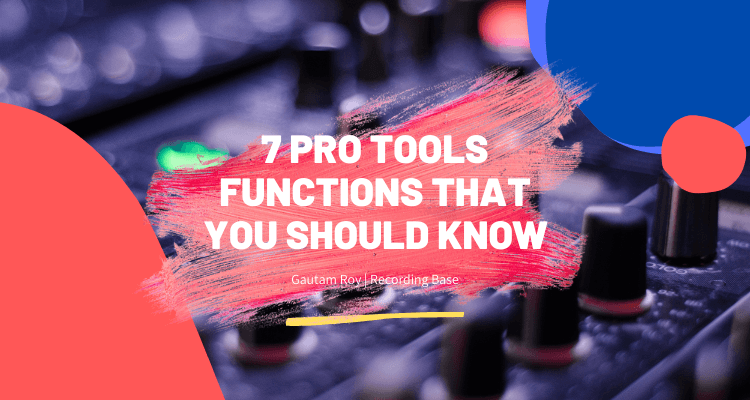Pro-Tools is considered the best DAW in the world. But the restrictions to use Pro-Tools hardware with the DAW limits it to big studios.
But now things have changed. Now Pro-Tools is compatible with any ASIO audio interface without any restriction.
Later but they realized that if they have to compete with others then remove the restrictions.
Well, after Pro-Tools soften its norms – “Pro-Tools hardware is not recommended when using Pro-Tools”, many of you might have adopted it as your DAW.
Read Lucy J Mitchell’s (a freelance Sound Editor and Dubbing Mixer for TV, Film, and Computer Games) advice on the key functions of Pro-Tools in her own words.
I am also a regular user of this legendary audio production tool and produced a lot of music with it. Well, here are 6 Pro-Tools functions you must have aware of them as a Pro-tools music producer.
In this article, we’ll learn 7 about Pro-Tools functions that help you record your projects quickly.
7 Pro Tools Functions You Must Aware of

1. Wave Height/Zoom
You can change the Wave zoom in multiple ways. Although I use control + rollerball. Zooming in and out is quite a required function when you edit your waveforms.
You have to zoom a lot when editing breathing so that you can see the transients more easily.
In the same way, you can change the height of the wave so that the clutters become more visible. You can use the Wave height function to remove clicks and pops.
I love this tool as it makes you able to edit your clips like a pro.
2. Fade Adaptability
Just like Wave Zoom and height function, there are lots of ways to add a fade to a clip, as well as you have lots of different ways to change a fade.
You can also move the fade backward and forwards on the timeline of Pro-tools once in place. As well as you can alter the boundary too.
If you want to change the length of the fade you just have to adjust the front of the fade. You can also change not just the straight or curved shape of the fade. You can make it S-shaped as well as alter the gradient of the curve, or even.
3. Track Groups
With (Command+G) function, your tracks can group together.
When using this tool, editing one track also alter the group tracks – like a clip, moving, breaking, trimming, fading. Automation like volume automation etc also altered together when grouped together.
Grouping is best when using two microphones for the same track.
It is also useful when you are always laying up 2 or 3 layers at a time. The grouping function saves you lots of time by holding downshifts when every time if you want to do the same editing.
When do you want you can easily deactivate the groups by pressing Shift+Command+G.
4. Paste To Selection (Option+Command+V)
You can use this function when copy or cut a long file, and when you want to paste it to a smaller section.
Mostly at the time of dialogue editing, pasting ‘silence’ in between words to remove the unwanted sound.
Just press Option+Command+V and voila! you can remove the white noise & impulse responses, or RX Advanced Ambience Match. I always use this technique when editing ambiance effects.
You can take it in the other way when you want to paste a short file into a longer section.
Pro Tools will then fill the entire selection by duplicating/looping your audio files. however, I rarely use it this way unless the file I’m pasting is too long, to begin with, like atmospheres.
5. Constrain Clip To Vertical Movement (Control+Drag Clip)
When you want complete accuracy when syncing up clips like sound effects you can use this function
When you use it, each track will then be directly below the other, at exactly the same timecode.
It can be also useful if you have to put a clip in one place, but you simply need to move it to another track, whether it’s a moving recorded Voice over an ‘alt take’ track, or if you accidentally laid up an effect on a dialogue track.
6. Duplicate Clip In Edit Window (Option/Alt+Drag Clip)
Don’t be confused with it as immediate duplication following a clip like Command+D, this is just dragging your clip where you want it to place, but by copying the clip – not moving it.
I use this to just quickly ‘copying’ a region, pasting it somewhere else, and then moving it to where I want it.
You can, however, skip this step! before you let go of your keyboard and therefore might change your mind about which track to place it on, You can also visualize how the clip will fit onto the timeline immediately.
7. Using X-Form + Elastic Properties
It’s one of the best methods for quick clip pitch and length changes. However, it doesn’t work very well for big changes but for quick changes, it is good enough. You can tweak X-Form and Elastic Properties independently.
Keep in mind, this is not a real-time process, so the changes will be rendered offline and you should keep the original version of the audio.
You have to activate X-Form to use this method and on the track for elastic properties, it’s located under the track automation mode.
Read also,
